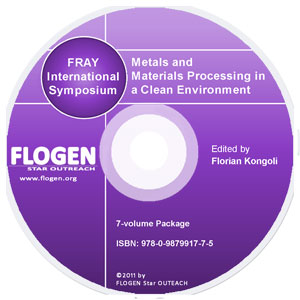
CD shopping page |
2011-Sustainable Industrial Processing Summit
|
| Editors: | Florian K |
| Publisher: | Flogen Star OUTREACH |
| Publication Year: | 2012 |
| Pages: | 708 pages |
| ISBN: | 978-0-9879917-1-3 |
| ISSN: | 2291-1227 (Metals and Materials Processing in a Clean Environment Series) |
EFFICIENT TECHNOLOGY FOR DE-ZINCING OF EAF WASTE DUST IN THE STEEL INDUSTRY
Perparim Demi1; Florian Kongoli2;1MIGRAL, Bucharest, Romania; 2FLOGEN TECHNOLOGIES INC., Mont-Royal, Canada;
Type of Paper: Invite
Id Paper: 568
Topic: 5
Abstract:
Several lab and pilot researches have been conducted during 2006 – 2008 in order to establish the adequate technology for the recycling of electrofilter dust from the electric-arc furnaces. The purpose of this research is to eliminate local air and soil pollution in the electric-arc furnace plants. The objective of this paper work is the design of a dust recycling technology under the current conditions of an existent plant in Romania, which produces approx. 500 tones of dust per year and has inherited an impressive stock of waste dump.This is an original procedure and it is based on specific experimental results and taking into consideration the real case of an electric-furnace steel plant – TMK CS Reşiţa. The pelletizing process for a self-reductant mixture (C ~ 15%), as well as the process of iron and zinc oxides reduction were under study. The dezincation and metallization coating of the mini-pellets obtained from the electriofilter dust enables the iron complete saving and recycling during the steel production process. Additionally, the granulated zinc concentrate, with a concentration of 50-70% ZnO and approx. 10-12% Pb is produced, which is recirculating in the non-ferrous industry. From the Fe concentration (~ 50%) and the metallization coating degree (70%) point of view, as well as the structure of the sterile resulting from the EAF slag, the quality of the metallized iron pellets is compatible to the process of steel production. The recycling costs do not exceed the value of the recovered iron and sterile, while the commercialisation of zinc concentrate (~ 200 kg/tone metallezed pellets) generates a significant profit. The recovery of reductant gas thermal and chemical energy additionally grows the efficiency of the recycling process.-------------------------------------------In the Steel Industry of Romania, near each production 's unit are accumulated istorical dusty waste dumps, powered by about 4,000 tons per month of EAF dust from current steel production. A recycling flux for this waste is not funded yet. A series of laboratory and pilot experimental research proved that recycling of this waste in the Iron metalized pellets form is a efficient funding. Our team designed the technological flow for EAF dust, where as a secondary product results is a marketable concentrate, contained 70 % of zinc oxide and 10 % of metallic lead.